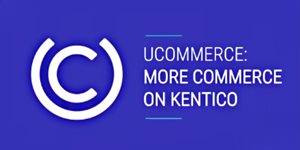Integrating Content-First and Commerce-First Approaches
With the release of Kentico 11 being just around the corner, Kentico announced an integration between its Enterprise Marketing Solution (EMS) and Content Management Solution (CMS) and Ucommerce, a fully featured .NET based e-commerce platform. The vendor contended that with the introduction of Kentico 11, scheduled for release in November 2017, customers will have the option to upgrade their e-commerce to Ucommerce.
between its Enterprise Marketing Solution (EMS) and Content Management Solution (CMS) and Ucommerce, a fully featured .NET based e-commerce platform. The vendor contended that with the introduction of Kentico 11, scheduled for release in November 2017, customers will have the option to upgrade their e-commerce to Ucommerce.
During my conversation with Karol Jarkovsky, Director of Product, at the Kentico Roadshow Boston event, he actually gave our audience the early signals of this integration by saying: “The e-commerce solution will see some improvements with Kentico 11, and these improvements will be more focused on integrations. We are planning to work with market leaders in the e-commerce space on delivering the optimal solutions for those organizations that are looking for the best of both CMS and e-commerce.” Knowing Kentico EMS and Kentico CMS come with a built-in e-commerce solution, why would Kentico roll out an integration with other commerce platforms, you may ask? According to Kentico, there are always organizations which want to use standalone best-of-breed e-commerce solutions, and the vendor wants to make sure they get everything over to its customers that they need.
Following up on that conversation, I was fortunate enough to sit down, once again, with Karol Jarkovsky to discuss Kentico 11 with integration to the Ucommerce engine. Here’s what he had to say:
Karol explained the motivation behind this particular partnership: “We have noticed there is a gap and an opportunity in the market to deliver a B2C and B2B platform that would combine a content-first and commerce-first solution. When we met with Ucommerce, due to the way they think of the market, the way they are positioned in the market, and their vision - even things like company culture that they have, we felt the instant click so we decided to talk about this opportunity.” He also stated that what appealed to Kentico was Ucommerce’s vision as they believe that it goes beyond proving fundamental e-commerce capabilities to optimizing sales and increasing revenue through recommendations powered by artificial intelligence technologies.
Even though Kentico’s e-commerce module is designed specifically for midsize companies in the $10M - $500M range, the platform has increasingly been capturing the attention of Fortune 500 / Global Fortune 500 companies as well. “While our native e-commerce capabilities are more than sufficient for small, medium-size, and even larger businesses, we recognized that larger corporations, particularly multinationals, have very specialized needs when it comes to e-commerce,” said Kentico CEO Petr Palas in a press release. “So rather than re-invent the wheel, we have opted to work with Ucommerce, a company that is both well-known and highly regarded in this space.”
To inquire about the synergy between the two vendors and how uCommerce will add value to  Kentico’s existing e-commerce module, we also reached out to Søren Spelling Lund, Founder and CEO at Ucommerce. “I am so excited for this opportunity for both us and Kentico because with the launch of this partnership, we will bring the best of both worlds: CMS and Ecommerce,” Søren told CMS-Connected. According to him, one of the cool things about this partnership is that uCommerce is heavily focused on the e-commerce side whereas Kentico’s heavy focus is on, as Soren puts it, “what they do great” which is content management. Therefore, Søren believes that the partnership is “a perfect match".
Kentico’s existing e-commerce module, we also reached out to Søren Spelling Lund, Founder and CEO at Ucommerce. “I am so excited for this opportunity for both us and Kentico because with the launch of this partnership, we will bring the best of both worlds: CMS and Ecommerce,” Søren told CMS-Connected. According to him, one of the cool things about this partnership is that uCommerce is heavily focused on the e-commerce side whereas Kentico’s heavy focus is on, as Soren puts it, “what they do great” which is content management. Therefore, Søren believes that the partnership is “a perfect match".
Bringing Content-First and Commerce-First Approach Together
Now that we are clear on the fact that this integration represents a Kentico-specific solution provided by Ucommerce rather than a replacement of Kentico’s baked-in e-commerce capabilities, let’s find out what the additional values of this option are for customers.
Kentico has seen the gap between what the vendor can possibly offer at the moment and its customers’ increasing demand for larger, more specialized e-commerce capabilities. In recognition of this need, instead of saying my way or the highway, Kentico made a strategic partnership with Ucommerce to elevate its customers’ e-commerce projects through brand-new, high-end capabilities.
Hot on the heels of the integration announcement, once again, we wanted to pick Karol Jarkovsky’s brain on Kentico 11 with integration to the Ucommerce engine and asked him what the biggest strengths for Kentico integrated with Ucommerce are. “We take a Content-first and Commerce-first approach to commerce, which means companies can take advantage of the core strengths of a full CMS and Online Marketing platform in combination with a fully-fledged commerce platform,” he told CMS-Connected. Additionally, he listed some specific capabilities that Kentico and Ucommerce together provide:
-
Built-in PIM capabilities - allow companies to manage and distribute products across multiple channels easily.
-
Highly flexible and extensible rule-based discounting engine - allow companies to create virtually any type of promotion to attract more customers and boost sales
-
Advanced order management integrated - allows companies to take full control over the order processing workflow (split shipments, payment processing - refund, partial payments, etc.)
-
Flexibility and extensibility (from B2C to B2B, from retail to kiosks with touchscreen).
We also inquired who their core clientele for this integrated commerce platform are. Karol explained: “Target segment for Kentico integrated with Ucommerce are MEB and global companies with multiple stores/brands with multichannel strategy in place, where a high level of flexibility and extensibility is required - both on commerce logic and store design, navigation, and structure.” According to Karol, the integrated platform is the right choice for businesses looking for a highly flexible, best-of-breed, multichannel e-commerce solution. When it comes to pricing, Karol stressed that Kentico Ucommerce integration requires a valid Kentico and Ucommerce license. On that note, Ucommerce price is EUR 5,999 per server per year.
Given that even the best idea can be improved upon, we also wanted to discuss with him about the areas of improvement that Kentico and Ucommerce will be addressing in the near future. “Ucommerce is a B2C platform first and foremost. Because of its extensible nature, B2B is supported as well for B2B/B2C scenarios in one, but it requires some customization to get there,” said Karol Jarkovsky. “Another area we want to improve on is digital merchant productivity. Managing huge lists of products, orders and customers every day needs a super-easy back office UI and ability to get things done quickly. At the same time, back office UI has to be flexible and extensible to fit specific needs and business workflows. All these topics are part of the upcoming Ucommerce update that helps all digital merchants to be more productive when dealing with day-to-day operations.”
My POV
Kentico’s collaboration with Ucommerce is addressing the increasing demand for being armed with a rich content management system (CMS) around a commerce engine. Besides its technical advantages for customers, from a business perspective, I see this integration as a very-well played strategic move as far as problem-solving goes because the vendor has, with all of the transparency, acknowledged the fact that some of its customers are in need for more nimble, tailored, and cutting-edge e-commerce capabilities than Kentico’s current native e-commerce module could offer, and to address those very specialized needs, it decided to give its customers an option to replace Kentico’s native E-commerce solution with the unique, Kentico-specific solution. After all, e-commerce is a laser-focus for Ucommerce. With more than 3,000 active websites running on uCommerce worldwide, more than 100 certified implementation partners and over 1,000 certified developers, the platform is widely utilized by e-commerce service providers and well-known global brands, including H.J. Heinz, BIC, British Library, Faber-Castell, Emirates, and Reebok.
To receive some market share from this unprecedentedly emerging e-commerce space, many CMS and CRM vendors are heavily investing in providing very viable e-commerce solutions either through acquisitions and strong partnership or from building the capabilities in-house. The main purpose of the partnership between Kentico and Ucommerce is smoothly integrating these two platforms together so end-users can get a unified view of content and commerce and they can manage everything from a single place without feeling the transition between the two environments.

Venus Tamturk
Venus is the Media Reporter for CMS-Connected, with one of her tasks to write thorough articles by creating the most up-to-date and engaging content using B2B digital marketing. She enjoys increasing brand equity and conversion through the strategic use of social media channels and integrated media marketing plans.